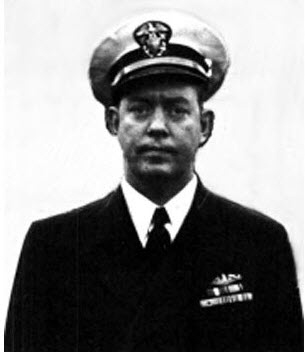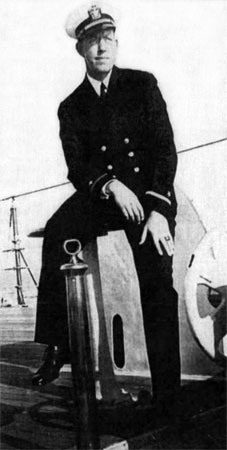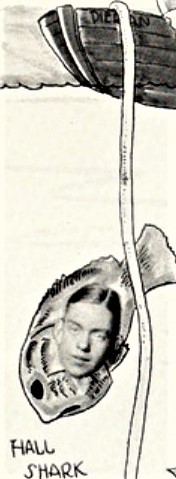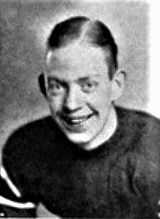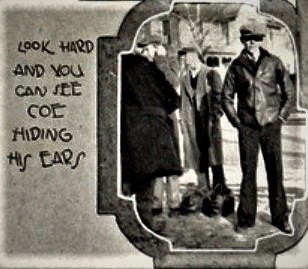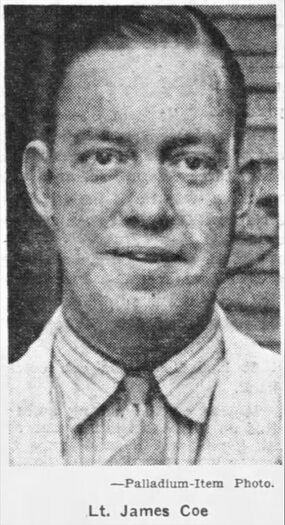JAMES W. COE, CDR, USN
James Coe '30
Lucky Bag
From the 1930 Lucky Bag:
JAMES WIGGINS COE
Richmond, Indiana
"Jim" "Wiggle" "Co Co"
STRONG drafts of salty air were not Jim's incentive to become one of Uncle Sam's pampered pets. He was given two weeks' notice, and then found himself undeniably on the banks of the Severn. He pulled himself together, saluted the Jimmy-Legs, and walked in to stake his claim.
Jim aspires to be the boy aviator of Richmond. His weird imitations of a wing-over, zoom, and a loop in succession as displayed on the diving board should be good practice for his future career. He takes off best when he runs the high hurdles for the track team. Youngster year he made a couple of Army men look like ground school students.
Red is usually the head man of any show worth while. His renditions on the fife are unsuppressed emotion. We believe he left a good carnival job to join the Navy. Whenever a good laugh is needed to cheer things up, Red is the doctor.
Jim possesses all of the good nature, compatibility and common sense that make friends with both sexes. He has managed well because he has always been on the safe side of women and academics.
Track 4, 3, 2, 1; Class Basketball 4; Gymkhana 4.
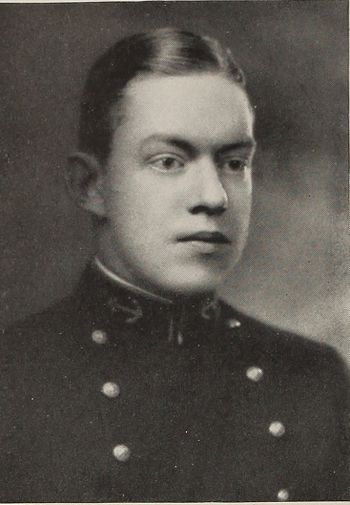
JAMES WIGGINS COE
Richmond, Indiana
"Jim" "Wiggle" "Co Co"
STRONG drafts of salty air were not Jim's incentive to become one of Uncle Sam's pampered pets. He was given two weeks' notice, and then found himself undeniably on the banks of the Severn. He pulled himself together, saluted the Jimmy-Legs, and walked in to stake his claim.
Jim aspires to be the boy aviator of Richmond. His weird imitations of a wing-over, zoom, and a loop in succession as displayed on the diving board should be good practice for his future career. He takes off best when he runs the high hurdles for the track team. Youngster year he made a couple of Army men look like ground school students.
Red is usually the head man of any show worth while. His renditions on the fife are unsuppressed emotion. We believe he left a good carnival job to join the Navy. Whenever a good laugh is needed to cheer things up, Red is the doctor.
Jim possesses all of the good nature, compatibility and common sense that make friends with both sexes. He has managed well because he has always been on the safe side of women and academics.
Track 4, 3, 2, 1; Class Basketball 4; Gymkhana 4.
Loss
James was lost when USS Cisco (SS 290) was sunk, likely on September 28, 1943 by Japanese ships and aircraft. He was the boat's commanding officer.
Other Information
From researcher Kathy Franz:
In January 1924, in a concert at the Morton high school auditorium, James and Thelma Feltis played a duet for two piccolos, the “Guard Mount” movement of the Carmen Suite, No. 2 by Georges Bizet.
James graduated from Morton high school in 1926. Academic. Football (end); Basketball (center); Captain Track; Hi-Y; Morton Civic; Band (flute and piccolo); Boys’ Glee Club. Jim’s hair is like a beacon to light him on his way; His fiery work in basketball is due to that, they say. On the basketball page: James “Red” Coe. Record, two years at center. “Dog-Ears” was a fine relief man and was an asset to the Morton team. “Red” is a three letter man, but we will have to kiss him good-bye after this track season is over, as he graduates.
The Richmond Radio Herald, 1941, school prophecy: The radio world has been very much delighted with the interesting and truthful statements which the Rev. James Coe has been broadcasting to the public from station AMEN, New York City. Rev. Coe’s main conclusion in yesterday’s sermon was that the youth of today are even worse than when he was a boy. Richmond citizens are proud to claim Rev. Coe as a former townsman. Some of the older residents recall his high school days, and how promising even then, Mr. Coe seemed for the ministry.
On the page Morton Sharks: “Say, Norm, you didn’t see any more of my friends down there, did ja’?”
“I certainly did. I heard someone say, ‘I’ll bite, what is it?” and knew at once it must be Jim Coe. There he was floating along just as he did up at Morton as Hall Shark. … when I told Jimmie and Arthur to behave themselves while I snapped their homely mugs, Jim told me I’d better save my films for some of the more beautiful inhabitants of the deep, who were Morton’s four heart-breakers, … the Football Shark, … the Basketball Shark, … the Sheik Shark … and the Latin Shark.”
From Palladium-Item, Richmond, Indiana, May 22, 1926, via researcher Kathy Franz:
James Coe Takes Extempore Oratory Honor at Morton
James Code, senior at Morton high school, was awarded the honor of having his name engraved on the George H. Knollenberg cup in winning first place in the extemporaneous oratorical contest held at Morton Friday. The cup was given to the high school for such a contest in 1917 and 10 students representing the class each year, have their names appearing on the cup. Mr. Coe won the honor for his oration on “Benefits That Follow Disaster.” Other contestants were George Peacock and Wilbur Pond. The jurymen were Miss Bernice Hadley, Prof. J. F. Thompson and R. L. Donaker.
From researcher Kathy Franz:
James along with five others drove to Indianapolis to attend the race in May, 1933. In December that year, he was the speaker at a luncheon meeting of the Altrusa club in Richmond. He spoke on the submarine service of the navy.
A news article in June, 1934, indicated that James had brought back some interesting pieces of tapa cloth from the South Sea Islands and presented them to the Wayne County Historical Museum.
James married Rachel Hayes Gawthrop of Wilmington, Delaware, on October 21, 1935, at St. Andrew’s Cathedral in Honolulu. Their daughter Jean was born March 30, 1937, in Honolulu; son Henry was born July 7, 1940, in Cavite, Philippines and daughter Mary Lee was born April 6, 1944, after James was declared lost in February.
From the Palladium-Item, Richmond, June 11, 1939, via researcher Kathy Franz:
Life on “Sub” Not so Bad, Local Naval Officer Says
Life on the often-called modern pirate ship – the submarine – is not as unsavory as the layman would think. In fact submarine work is one of the most coveted duties in the U. S. navy to both officers and enlisted men.
There is an intimate camaraderie between seamen and officers on a diving vessel, the like of which is unknown among crews on battleships, cruisers, and other larger water craft. Then, too, the food’s a trifle better on a sub. Of course, the fact that the pay is higher hardly means anything to the sailors, who are fortunate enough to be assigned to a submarine.
It’s a rosy picture – life on a sub – that Lt. James Coe painted recently for an interviewer. Jimmy, as he is known to Richmond friends, is the guest of his mother ... but not for long.
For Monday he and his wife and daughter, Jean, will leave for the west coast where on June 30 the Coes will bid farewell to the sunshine of California and head for Manila on a commercial steamer.
Assigned to Fleet
Jimmy has been assigned to the Asiatic fleet that shuttles between China and the Philippines, and he’ll be riding the waters of the South China sea aboard a submarine.
At the least he will be stationed in the Far East for two and one-half years, but circumstances can either shorten or lengthen his duty there.
It will be quite a change for the entire family. For the past two years the big, red-headed naval officer has been engaged in teaching navigation at Annapolis and enjoying the pleasurable life of shore duty.
Following his graduation from the naval academy in 1930, Jimmy served for a time on the battleship, Nevada, and later on the heavy cruiser, Chicago. He attended submarine school in New London, Conn., for nearly a year before being assigned to active sub duty in the fleet stationed at Honolulu. After three years there, Jimmy was recalled in 1937 to the United States and given the tutorship at Annapolis.
Interesting experiences and hair-raising adventures? Of course, he’s had aplenty, but the navy frowns on its officers telling reporters intimate details about life in the navy.
His wife and children were in Manila with him, but returned in March, 1941, to the United States. James was supposed to be relieved of his submarine command after a two-year tour of duty on December 20, 1941, but his relief became ill.
From the Palladium-Item, August 13, 1942, via researcher Kathy Franz:
From that day’s editorial which stated James’ parents were: Two finer, more capable, less unassuming persons than these never lived in Richmond.
The capability has been handed on to their son. Generally you don’t have a promotion in our navy given to you on a silver platter; you earn it.
That the unassumingness has also reappeared in the son is shown by these words from a fine letter he wrote to his mother here: “I am finally a lieutenant commander, along with many others, but rank doesn’t mean a thing to me now and that’s no fooling. This war has changed all that – it’s the job you’re doing and how you’re doing it that counts. The gold braid is superfluous . . . .
“They gave me the navy cross recently. My officers and crew and the two boats we served on really won it, but it is a good feeling to know that after all the training and time that my country has spent on me that I have at last been able to repay it to some extent, and hope to keep on doing it with interest. . . .”
From Palladium-Item, October 22, 1942, via researcher Kathy Franz:
A letter received by Mrs. Demas Coe from her son, Lt. Comdr. James Coe, who is head man of a U. S. submarine in the Pacific, is an example of the success of the recent local Victory book campaign, in which volumes were collected for boys in camps and abroad.
Lieutenant Commander Coe writes that he has received a first copy of James Whitcomb Riley’s “Arminzindy” which is much appreciated by himself as well as by his officers and men.
He has asked his mother to thank those responsible and adds that some day he hopes to do it in person.
Mrs. Ada Bernhardt, librarian of the Morrisson-Reeves library, who directed the campaign, said the book was chosen for him especially since she knew he was interested in Riley’s work.
. . . he also wrote:
“I much enjoy your letters, but my letters must be very dull. I shall have to wait until I return home to tell you everything. I think it would be best if no one mails gifts over for holidays. We can have a family reunion later and celebrate all the anniversaries and holidays at that time.
“There is never a dull moment around here, but of course that holds true for everyone in these times.”
From the Palladium-Item, January 9, 1943, via researcher Kathy Franz:
Coe Believes American People Must Realize Jap Fighting Power Before Victory Can Be Won
Editor’s note – This has been submitted to the Office of Censorship at Washington, which found no objection.
By Maynard Bertsch
“Those Japs are excellent seamen and they have good ships. They are hard nuts to crack,” said Lt. Comdr. James W. Coe, former Richmond boy who is credited with the sinking of 55,000 tons and the damaging of an additional 14,000 tons of enemy shipping.
Coe is home for a few days enjoying a vacation with his mother, Mrs. Demas Coe.
“It’s good to be off the submarine, off the alert, and have a chance to relax,” Coe admitted.
He said the people of this nation have not taken the Japs as seriously as they should and believes that the sooner Americans recognize the fact these Japs are doing an efficient job of fighting the sooner we will win the war.
In an interview this week the former Richmond man said the Japs are skillful in taking retaliatory measures, and are ingenious in their use of various ruses.
Lieutenant Commander Code has been in the submarine service since 1933. During that time he has been stationed on submarines except for a short time when detail called for shore duty at Annapolis. In July, 1939, Coe was assigned to the Philippine islands with the Asiatic fleet.
Gets Different Type Sub
In January, 1940, Coe took command of an “S” type submarine. Shortly after the beginning of this war he was transferred from the “S” type submarine and assigned to one of the fleet type.
While commanding this submarine he has had a variety of experience. However, most of these experiences are such that the Richmond man does not wish to discuss or disclose their nature.
“Our crew has had many unpleasant experiences with the Japs but with a lot of good-hearted wood knocking all worked out well,” Coe said.
“Many of our engagements have been rather hot and we’re glad to be home. We’ve been scared to h--- and back many times and while thrilling, it’s not always of the pleasant variety.
“It is a big satisfaction for everybody on the submarine to make a contact and carry it through,” Coe said. “Perhaps it’s not the humane thing to watch but there is some satisfaction in seeing a Jap ship start to go down and become enveloped in the sea.
“There is one real thrill,” Coe said “and that’s when a torpedo from our submarine scores a hit. We can always tell when our torpedo strikes home.”
War Not Won Yet
Coe has one observation concerning the newspaper reports on the progress of the battles between the Americans and the Japs. He says he thinks the cases brought to the attention of the people are the exceptional ones. Even though we have had reports of men who have shot down a dozen or more Japs or some member of the armed forces taking in a number of the enemy single-handed, that doesn’t mean we have them conquered by any means, Coe warned.
Speaking of Australia, he says the women are doing all types of work there. They are conscious of this war and every person is doing his share to keep the country free of the bonds of Hitlerism and slavery. Women drive taxis, streetcars, work in factories and operate the big ranches. “They are not afraid of manual work,” he says.
“Their patriotism is wonderful and everyone is doing something to win the war. All the able-bodied men are at the front. Cars are few and far between. Gasoline is scarce and most of the cars use charcoal burners to provide power. Gasoline is used only to get the cars started.”
According to Coe things are beginning to look better. “The best thing that I have seen in the last few months is the arrival of a lot of equipment made in this country and believed delivered at the right place at the right time,” Coe said.
Coe spoke of one rough engagement they had been through, referring specifically to the cook on his sub. He stated that the crew loves to eat, particularly after a good hard fracas. This one had been especially unpleasant and when everything was over the boys headed for chow. The meal was not ready and as the cook hurriedly threw the meal together he shook his head in mock sadness and said, “You know for a while there I didn’t think I’d have to get any dinner ready.”
Lieutenant Commander Coe says he always thinks of Richmond and the folks back home after they have had a good hot engagement. “There is one thing I would like to be able to do at a time like that,” he said. “That is to sit in one of my mother’s easy chairs with my feet propped up and enjoy the evening paper. That would be perfect relaxation.”
From researcher Kathy Franz:
On May 24, 1943, James was interviewed by a radio broadcaster. He recounted personal experience, and the broadcast was heard by a number of Richmond persons.
His father was Demas, a newspaperman and president of the J. M. Coe printing company. He died in 1934. James’ mother was Mary Phoebe, a third-grade teacher, and his sister was Margaret (Mrs. James M. Dikeman, Jr.)
His wife was listed as next of kin. He has a memory marker in California.
Photographs
Career
James began his career aboard USS Nevada (BB 36) before transferring to USS Chicago (CA 29) for service in 1931-1933. He attended submarine school in 1933, then served on USS S-27 (SS 132) in 1934-1935 and USS S-33 (SS 138) in 1936-1937.
From the now-broken link http://www.fleetorganization.com/subcommandersclassyear2.html:
- Instructor United States Naval Academy 1937 - May 1939
- Duty Submarine Squadron Five 1 Oct 1939
- Executive Officer USS S-36 (SS-141) 31 Dec 1939
- Captain USS S-39 (SS-144) 31 Jan 1940 - 18 Mar 1942
- Captain USS Skipjack (SS-184) 28 Mar 1942 - 17 Jan 1943
- Captain USS Cisco (SS-290) 10 May 1943 - Sep 1943
- Lieutenant 30 Jun 1938
- Lieutenant Commander (T) 15 Jun 1942
- Commander (T) 15 Oct 1942
From Hall of Valor:
The President of the United States of America takes pleasure in presenting the Navy Cross to Lieutenant Commander James Wiggins Coe (NSN: 0-63137), United States Navy, for extraordinary heroism in the line of his profession as Commanding Officer of the U.S.S. S-39 (SS-144) during the FIRST through the FOURTH War Patrols in the Southwest Pacific from 8 December 1941 through March 1942, and as Commanding Officer of the U.S.S. SKIPJACK (SS-184), on the THIRD War Patrol of that submarine during the period 14 April 1942 to 17 May 1942, in enemy controlled waters at Cam Ranh Bay. While conducting war patrols as Commanding Officer of the U.S.S. S-39, Lieutenant Commander Coe boldly and successfully delivered an attack under hazardous and difficult conditions which resulted in the sinking of an armed enemy auxiliary vessel in Philippine waters, and later, a large enemy naval tanker in the Java Sea. Furthermore, while Commanding Officer of the U.S.S. SKIPJACK, he skillfully evaded enemy naval and air patrols to deliver a vigorous and effectively executed attack against enemy vessels, armed or escorted by anti-submarine craft. In these engagements, the SKIPJACK succeeded in destroying two large enemy auxiliaries and an enemy Japanese transport in the South China Sea and seriously damaging and presumably sinking another enemy armed auxiliary. Lieutenant Commander Coe displayed the outstanding characteristics of a leader, and the aggressive and intrepid spirit of a fine seaman which were in keeping with the traditions of the United States Naval Service.
Service: Navy
Division: USS S-39 (SS 144) & USS Skipjack (SS 184)
Rank: Lieutenant Commander
Toilet Paper Letter
From Together We Served:
One of the funniest memorandums to come out of World War II and one that was later featured in the movie Operation Petticoat was the (in)famous Toilet Paper letter. Its author was none other than Lieutenant Commander Coe, at the time skipper of the Skipjack. Here it is:
USS SKIPJACK June 11, 1942
From: Commanding Officer
To: Supply Officer, Navy Yard, Mare Island, California
Via: Commander Submarines, Southwest PacificSubject: Toilet Paper
Reference: (a) USS HOLLAND (5148) USS SKIPJACK req. 70-42 of 30 July 1941.
(b) SO NYMI Canceled invoice No. 272836Enclosure: (1) Copy of cancelled Invoice
(2) Sample of material requested.1. This vessel submitted a requisition for 150 rolls of toilet paper on July 30, 1941, to USS HOLLAND. The material was ordered by HOLLAND from the Supply Officer, Navy Yard, Mare Island, for delivery to USS SKIPJACK.
2. The Supply Officer, Navy Yard, Mare Island, on November 26, 1941, cancelled Mare Island Invoice No. 272836 with the stamped notation "Cancelled---cannot identify." This cancelled invoice was received by SKIPJACK on June 10, 1942.
3. During the 11 ¾ months elapsing from the time of ordering the toilet paper and the present date, the SKIPJACK personnel, despite their best efforts to await delivery of subject material, have been unable to wait on numerous occasions, and the situation is now quite acute, especially during depth charge attack by the "back-stabbers."
4. Enclosure (2) is a sample of the desired material provided for the information of the Supply Officer, Navy Yard, Mare Island. The Commanding Officer, USS SKIPJACK cannot help but wonder what is being used in Mare Island in place of this unidentifiable material, once well known to this command.
5. SKIPJACK personnel during this period have become accustomed to use of "ersatz," i.e., the vast amount of incoming non-essential paper work, and in so doing feel that the wish of the Bureau of Ships for the reduction of paper work is being complied with, thus effectively killing two birds with one stone.
6. It is believed by this command that the stamped notation "cannot identify" was possible error, and that this is simply a case of shortage of strategic war material, the SKIPJACK probably being low on the priority list.
7. In order to cooperate in our war effort at a small local sacrifice, the SKIPJACK desires no further action be taken until the end of the current war, which has created a situation aptly described as "war is hell."
J.W. CoeHere is the rest of the story:
The letter was given to the Yeoman, telling him to type it up. Once typed and upon reflection, the Yeoman went looking for help in the form of the XO. The XO shared it with the OD and they proceeded to the CO's cabin and asked if he really wanted it sent. His reply, "I wrote it, didn't I?"
As a side note, twelve days later, on June 22, 1942 J.W. Coe was awarded the Navy Cross for his actions on the S-39 and the Skipjack.
The "toilet paper" letter reached Mare Island Supply Depot. A member of that office remembers that all officers in the Supply Department "had to stand at attention for three days because of that letter." By then, the letter had been copied and was spreading throughout the fleet and even to the President's son who was aboard the USS Wasp.
As the boat came in from her next patrol, Jim and crew saw toilet-paper streamers blowing from the lights along the pier and pyramids of toilet paper stacked seven feet high on the dock. Two men were carrying a long dowel with toilet paper rolls on it with yards of paper streaming behind them as a band played coming up after the roll holders. Band members wore toilet paper neckties in place of their Navy neckerchiefs. The wind-section had toilet paper pushed up inside their instruments and when they blew, white streamers unfurled from trumpets and horns.
As was the custom for returning boats to be greeted at the pier with cases of fresh fruit/veggies and ice cream, the Skipjack was first greeted thereafter with her own distinctive tribute-cartons and cartons of toilet paper.
This letter became famous in submarine history books and found its way to the movie ("Operation Petticoat"), and eventually coming to rest (copy) at the Navy Supply School at Pensacola, Florida. There, it still hangs on the wall under a banner that reads, "Don't let this happen to you!" Even John Roosevelt ensured his father got a copy of the letter.
The original is at Bowfin Museum in Hawaii.
Class Panel Placement
It is unclear why James' name is so late on the Class of 1930 panel in Memorial Hall. Presumably he was officially declared dead in late 1945 or 1946; his loss date would place him many names higher.
The "Register of Commissioned and Warrant Officers of the United States Navy and Marine Corps" was published annually from 1815 through at least the 1970s; it provided rank, command or station, and occasionally billet until the beginning of World War II when command/station was no longer included. Scanned copies were reviewed and data entered from the mid-1840s through 1922, when more-frequent Navy Directories were available.
The Navy Directory was a publication that provided information on the command, billet, and rank of every active and retired naval officer. Single editions have been found online from January 1915 and March 1918, and then from three to six editions per year from 1923 through 1940; the final edition is from April 1941.
The entries in both series of documents are sometimes cryptic and confusing. They are often inconsistent, even within an edition, with the name of commands; this is especially true for aviation squadrons in the 1920s and early 1930s.
Alumni listed at the same command may or may not have had significant interactions; they could have shared a stateroom or workspace, stood many hours of watch together, or, especially at the larger commands, they might not have known each other at all. The information provides the opportunity to draw connections that are otherwise invisible, though, and gives a fuller view of the professional experiences of these alumni in Memorial Hall.
October 1930
January 1931
October 1931
January 1932
April 1932
October 1932
January 1933
LTjg William Pennewill '29 (Scouting Plane Squadron (VS) 10S)
April 1933
LTjg William Pennewill '29 (Scouting Plane Squadron (VS) 10S)
July 1933
October 1933
April 1934
July 1934
October 1934
January 1935
April 1935
October 1935
January 1936
April 1936
July 1936
January 1937
April 1937
September 1937
LT Robert Bedilion '22
LT William Hobby, Jr. '23
LT Richard Baron '24
LT Richard Gingras '25
LT Harold Pound '25
LT William Graham, Jr. '25
LT Andrew Harris '25
LT Ralph Hickox '27
LTjg John Bermingham '29
January 1938
LT Robert Bedilion '22
LT William Hobby, Jr. '23
LT Richard Baron '24
LT Richard Gingras '25
LT Harold Pound '25
LT William Graham, Jr. '25
LT Andrew Harris '25
LT Ralph Hickox '27
LT John Bermingham '29
July 1938
LT William Hobby, Jr. '23
LT Richard Baron '24
LT Harold Pound '25
LT William Graham, Jr. '25
LT Andrew Harris '25
LT Hilan Ebert '26
LT John Bermingham '29
LT Egbert Roth '29
LT Victor Gaulin '30
LTjg Russell Ross '30
LT John Bisson '30
January 1939
LCDR Robert Bedilion '22
LCDR William Hobby, Jr. '23
LT Richard Baron '24
LT Harold Pound '25
LT William Graham, Jr. '25
LT Andrew Harris '25
LT Hilan Ebert '26
LT John Bermingham '29
LT Egbert Roth '29
LT Victor Gaulin '30
LT Russell Ross '30
October 1939
June 1940
November 1940
April 1941

The "category" links below lead to lists of related Honorees; use them to explore further the service and sacrifice of alumni in Memorial Hall.
